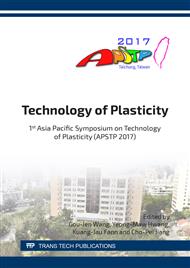[1]
O. Richmond, S. Alexandrov, The theory of general and ideal plastic deformations of Tresca solids. Acta Mech. 158(1-2) (2002) 33-42.
DOI: 10.1007/bf01463167
Google Scholar
[2]
R. Hill, Ideal forming operations for perfectly plastic solids, J. Mech. Phys. Solids 15 (1967) 223-227.
DOI: 10.1016/0022-5096(67)90034-8
Google Scholar
[3]
O. Richmond, Theory of Streamlined Dies for Drawing and Extrusion, in: F. P. J. Rimrott, J. Schwaighofer (Eds.), Mechanics of the Solid State, Toronto: University of Toronto Press, 1968, pp.154-167.
DOI: 10.3138/9781487575199-014
Google Scholar
[4]
O. Richmond, M. L. Devenpeck, A die profile for maximum efficiency in strip drawing, in: R. M. Rosenberg (Ed.) Proc. 4th. U.S. Natl. Congr. Appl. Mech. Vol.2. New York: ASME, 1962, pp.1053-1057.
Google Scholar
[5]
O. Richmond, H. L. Morrison, Streamlined wire drawing dies of minimum length, J. Mech. Phys. Solids 15 (1967) 195-203.
DOI: 10.1016/0022-5096(67)90032-4
Google Scholar
[6]
K. Chung, S. Alexandrov, Ideal flow in plasticity, Appl. Mech. Rev. 60 (2007) 316-335.
Google Scholar
[7]
F. Barlat, K. Chung, O. Richmond, Anisotropic potentials for polycrystals and application to the design of optimum blank shapes in sheet forming, Metall. Mater. Trans. A 25 (1994) 1209-1216.
DOI: 10.1007/bf02652295
Google Scholar
[8]
K. Chung, F. Barlat, J. C. Brem, D. J. Lege, O. Richmond, Blank shape design for a planar anisotropic sheet based on ideal sheet forming design theory and FEM analysis, Int. J. Mech. Sci. 39 (1997) 105-120.
DOI: 10.1016/0020-7403(96)00007-0
Google Scholar
[9]
S. H. Park, J. W. Yoon, D. Y. Yang, Y. H. Kim, Optimum blank design in sheet metal forming by the deformation path iteration method, Int. J. Mech. Sci. 41 (1999) 1217-1232.
DOI: 10.1016/s0020-7403(98)00084-8
Google Scholar
[10]
S. Alexandrov, Y. Mustafa, E. Lyamina, Steady planar ideal flow of anisotropic materials. Meccanica 51(9) (2016) 2235-2241.
DOI: 10.1007/s11012-016-0362-x
Google Scholar
[11]
I. F. Collins, S. A. Meguid, On the influence of hardening and anisotropy on the plane-strain compression of thin metal strip, ASME J. Appl. Mech. 44 (1977) 271-278.
DOI: 10.1115/1.3424037
Google Scholar
[12]
J.R. Rice, Plane strain slip line theory for anisotropic rigid/plastic materials. J. Mech. Phys. Solids 21, (1973) 63–74.
DOI: 10.1016/0022-5096(73)90030-6
Google Scholar
[13]
S. Alexandrov, W. Jeong, A Method of Analysis for Planar Ideal Plastic Flows of Anisotropic Materials, Acta Mech. (2017) https://doi.org/10.1007/s00707-017-1915-3.
DOI: 10.1007/s00707-017-1915-3
Google Scholar
[14]
W. A. Spitzig, R .J. Sober and O. Richmond, The Effect of Hydrostatic Pressure on the Deformation Behavior of Maraging and HY-80 Steels and Its Implications for Plasticity Theory, Metallurg. Trans. 7A (1976) pp.1703-1710.
DOI: 10.1007/bf02817888
Google Scholar
[15]
A. S. Kao, H. A. Kuhn, W. A. Spitzig, and O. Richmond, Influence of Superimposed Hydrostatic Pressure on Bending Fracture and Formability of a Low Carbon Steel Containing Globular Sulfides, Trans. ASME J. Eng. Mater. Technol. 112 (1990) pp.26-30.
DOI: 10.1115/1.2903182
Google Scholar
[16]
C. D. Wilson, A Critical Reexamination of Classical Metal Plasticity, Trans. ASME J. Appl. Mech. 69 (2002) pp.63-68.
DOI: 10.1115/1.1491578
Google Scholar
[17]
P. S. Liu, Mechanical Behaviors of Porous Metals Under Biaxial Tensile Loads, Mater. Sci. Eng. A422 (2006) pp.176-183.
Google Scholar
[18]
D. Harris, A hyperbolic augmented elasto-plastic model for pressure-dependent yield, Acta Mech. 225 (2014) 2277-2299.
DOI: 10.1007/s00707-014-1129-x
Google Scholar
[19]
S. Alexandrov and D. Harris, An exact solution for a model of pressure-dependent plasticity in an un-steady plane strain process, Eur. J.Mech.-A/Solids 29 (2010) 966-975.
DOI: 10.1016/j.euromechsol.2010.04.002
Google Scholar
[20]
S. Alexandrov, Steady planar ideal plastic flows for the double slip and rotation model, in: M. Vandamme, P. Dangla, J.-M. Pereira, S. Ghabezloo (Eds.), Proc. 6th Biot Conf. Poromechanics (Poromechanics VI), 2017, pp.967-971.
DOI: 10.1061/9780784480779.120
Google Scholar
[21]
A.J.M. Spencer, A theory of the kinematics of ideal soils under plane strain conditions, J. Mech. Phys. Solids 12 (1964) 337-351.
DOI: 10.1016/0022-5096(64)90029-8
Google Scholar
[22]
R. Hill, The mathematical theory of plasticity, Oxford, Clarendon Press, (1950).
Google Scholar


